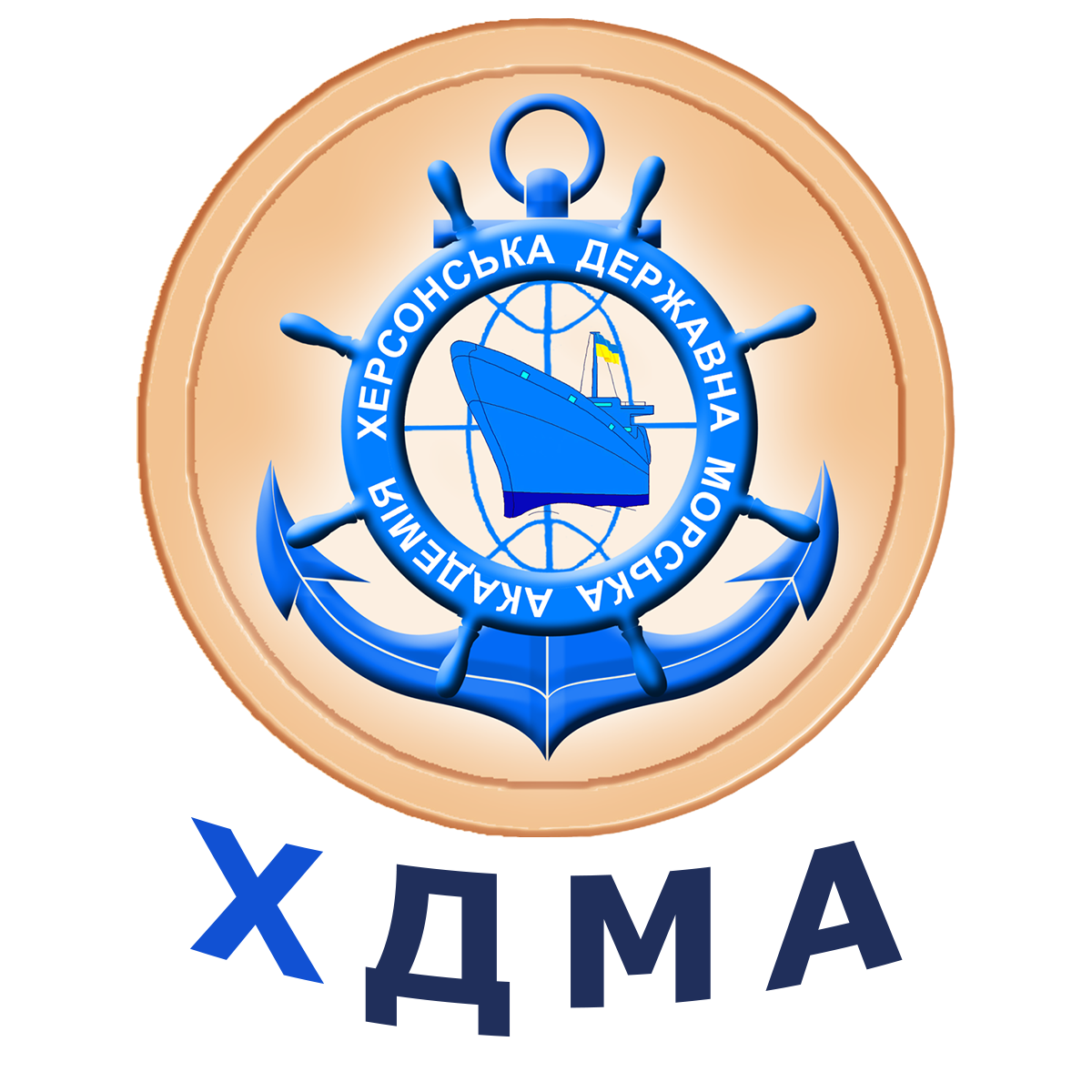Репозитарій
Ласкаво просимо до репозитарію Херсонської державної морської академії!
Репозитарій ХДМА – це електронний архів, що виконує функції накопичення, систематизації, зберігання та
забезпечення довготривалого відкритого доступу до праць професорсько-викладацького складу.

Фонди
Виберіть фонд, щоб переглянути його зібрання.
Нові надходження
From classrooms to global connections: The impact of extra-curricular activities on GMP competency building.
(University of Dubrovnik, Faculty of Maritime Studies, 2025-09-18) Швецова І.В.; Shvetsova І.V.
In response to the growing complexity and globalization of the maritime industry, the International Association of Maritime Universities (IAMU) introduced the Global Maritime Professional Body of Knowledge (GMP BoK), which outlines a comprehensive framework of knowledge, skills, and attitudes (KSAs) required for future maritime professionals. This study explores the integration of extracurricular activities as a structured pedagogical strategy for developing soft skills aligned with the Tier A affective learning outcomes of GMP BoK. The research was conducted at Kherson State Maritime Academy and the Maritime Professional College in Ukraine in partnership with international academic institutions. Over the period 2019 – 2025, 553 cadets participated in a series of international and interdisciplinary extracurricular initiatives, including COIL projects, webinars, team-based quests, and poster sessions. A mixed-methods approach was used, incorporating psychometric testing, surveys, self- assessments, and observation. The findings demonstrate that participation in extracurricular activities significantly enhanced cadets’ leadership, teamwork, interpersonal communication, ethical responsibility, proactivity, and decision-making. The study offers a structured mapping of all eleven GMP BoK soft skill areas and proposes a new model for evaluating the transition from awareness to action through cadets’ reflective and proactive engagement. The research highlights the strategic role of affective learning in maritime education and advocates for the institutional integration of extracurricular programming as a catalyst for developing globally competent and safety-oriented maritime professionals.
У відповідь на зростання складності та глобалізації морської галузі Міжнародна асоціація морських університетів (IAMU) запровадила Global Maritime Professional Body of Knowledge (GMP BoK) – комплексну структуру знань, умінь і ставлень (KSA), необхідних майбутнім фахівцям морської індустрії. У роботі розглядається інтеграція позааудиторної діяльності як структурованої педагогічної стратегії для розвитку «soft skills», узгоджених із афективними результатами навчання рівня Tier A відповідно до GMP BoK. Дослідження проведено в Херсонській державній морській академії та Морському професійному коледжі (Україна) у партнерстві з міжнародними академічними інституціями.
Упродовж 2019–2025 рр. 553 курсанти взяли участь у низці міжнародних та міждисциплінарних позааудиторних ініціатив, зокрема COIL-проєктах, вебінарах, командних квестах і постерних сесіях. Використано змішану методологію дослідження: психометричне тестування, опитування, самооцінювання та спостереження. Отримані результати засвідчили, що участь у позааудиторній діяльності істотно підвищила рівень лідерства, командної взаємодії, міжособистісної комунікації, етичної відповідальності, проактивності та здатності до ухвалення рішень серед курсантів.
Робота пропонує структуроване зіставлення одинадцяти сфер «soft skills» GMP BoK та нову модель оцінювання переходу від обізнаності до активної дії на основі рефлексивної та проактивної участі курсантів. Матеріал підкреслює стратегічну роль афективного навчання у морській освіті та обґрунтовує необхідність інституціалізації позааудиторних програм як каталізатора формування глобально компетентних і орієнтованих на безпеку морських фахівців.
Digital framework for developing the sociolinguistic competence of future navigators within Maritime English 4.0.
(ДІНУОМА, 2025) Швецова І.В.; Shvetsova І.V.
The paper outlines approaches to developing the sociolinguistic competence of future navigators through a digital framework that integrates Maritime English 4.0 tools with XR technologies, scenario-based modelling of professional communicative situations, and AI-supported language solutions. The proposed model recreates operational contexts of the digital bridge, typical communicative roles, and intercultural interaction formats, which contributes to the development of radio communication accuracy, status-role behaviour, and preparedness for decision-making in high-risk conditions. The presented approaches demonstrate the potential of digital technologies to modernise the content of professional language training in accordance with the requirements of the STCW Convention and IMO Model Courses.
У роботі окреслено підходи до формування соціолінгвістичної компетентності майбутніх навігаторів на основі цифрового фреймворку, що інтегрує інструменти Maritime English 4.0 з технологіями XR, сценарним моделюванням професійних комунікативних ситуацій та AI-підтримкою мовленнєвих рішень. Представлена модель забезпечує відтворення операційних контекстів цифрового мостика, типових комунікаційних ролей і міжкультурних форматів взаємодії, що сприяє розвитку точності радіообміну, статусно-рольової поведінки та готовності до прийняття рішень у ризиконасичених умовах. Викладені підходи демонструють потенціал цифрових технологій для модернізації змісту професійної мовної підготовки відповідно до вимог STCW та IMO Model Courses.
Immersive Technologies in Maritime Language Training: Updating The Linguistic-Technological Component for the Digital Era.
(ECONOMIA MARCHE Journal of Applied Economics, 2025-11-25) Швецова І.В.; Shvetsova І.V.
This paper examines a systemic approach to enhancing foreign language communicative competence among maritime navigation and ship handling specialists by integrating digital tools into vocational education and training (VET). The study highlights the growing need for seafarers to combine technical expertise with advanced English proficiency supported by immersive technologies and flexible learning formats.
The proposed model incorporates English for Specific Purposes (ESP), including Maritime and Business English, into a digitally enhanced training framework. It leverages virtual and augmented reality, AI-assisted environments, and collaborative international online learning to foster both language development and operational readiness. The approach is aligned with lifelong learning principles and supports rapid upskilling and reskilling in line with Industry 4.0 requirements.
Key components include ESP-based courses tailored to operational, managerial, and leadership competencies, delivered through blended and online formats on the MOODLE platform. These contribute to both initial training and continuing professional development.
Findings underscore the pedagogical value of immersive technologies in improving digital fluency, promoting autonomous learning, and fostering entrepreneurial thinking. The model provides a scalable framework that enhances communicative resilience in dynamic maritime contexts and may inform broader innovation strategies in maritime VET systems.
У цій статті розглядається системний підхід до підвищення комунікативної компетенції іноземних мов серед фахівців з морського судноплавства та управління суднами шляхом інтеграції цифрових інструментів у професійну освіту та підготовку (ПТО). Дослідження підкреслює зростаючу потребу моряків у поєднанні технічних знань з поглибленим володінням англійською мовою за допомогою імерсивних технологій та гнучких форматів навчання.
Запропонована модель об’єднує англійську мову для спеціальних цілей (ESP), включаючи морську та ділову англійську, в цифрову систему навчання. Вона використовує віртуальну та доповнену реальність, середовища на основі штучного інтелекту та спільне міжнародне онлайн-навчання для сприяння як розвитку мови, так і операційній готовності. Цей підхід узгоджується з принципами навчання протягом усього життя та підтримує швидке підвищення кваліфікації та перекваліфікацію відповідно до вимог Індустрії 4.0.
Ключові компоненти включають курси на основі англійської мови для спеціалістів, адаптовані до операційних, управлінських та лідерських компетенцій, що проводяться у змішаному та онлайн-форматах на платформі MOODLE. Вони сприяють як початковому навчанню, так і безперервному професійному розвитку.
Результати дослідження підкреслюють педагогічну цінність імерсивних технологій у покращенні цифрової грамотності, сприянні автономному навчанню та розвитку підприємницького мислення. Модель забезпечує масштабовану основу, яка підвищує комунікативну стійкість у динамічних морських контекстах і може бути основою для ширших інноваційних стратегій у системах морської професійної освіти.
Гейміфікація у навчанні англійської мови: аналіз онлайн-сервісів та практичні можливості.
(Гельветика, 2025) Ліхошерстова В.Г.; Likhosherstova V.G.
У статті розглядається застосування гейміфікації у процесі вивчення англійської мови як засобу підвищення мотивації, когнітивної активності та емоційної залученості здобувачів освіти. Проаналізовано наукові дослідження вітчизняних та зарубіжних учених, присвячені питанням впровадження ігрових елементів у навчальний процес та їхньої ефективності. У роботі здійснено огляд сучасних онлайн-сервісів, які можуть бути використанні викладачами для інтеграції ігрових елементів у заняття з англійської мови, зокрема Twinkl, iSL Collective, ESL Kids Games, ESL Games+ та Pinterest. Також розглянуто інструменти для створення авторських дидактичних ігор – Canva, Genially та Microsoft PowerPoint. Окреслено можливості організації занять як в онлайн-форматі (Zoom, Google Meet), так і в аудиторії. Зазначено практичну цінність сервісу Online Stopwatch як допоміжного ресурсу для управління ігровим та навчальним процесом. Описано досвід використання ігрових елементів під час вивчення освітньої компоненти «Морська англійська мова» зі здобувачами освіти Херсонської державної морської академії. Зазначено, що гейміфікація сприяє розвитку комунікативних навичок, формуванню мовленнєвої компетентності, зниженню психологічного бар'єру під час спілкування та підвищенню навчальної мотивації. Водночас наголошено на важливості педагогічно виваженого підходу до впровадження гейміфікаційних практик, оскільки непродумане використання ігрових елементів може знижувати ефективність засвоєння матеріалу. Стаття має практичне значення для викладачів та вчителів англійської мови, які прагнуть підвищити результативність навчального процесу шляхом інтеграції ігрових технологій та сучасних цифрових інструментів.
The article explores the use of gamification in the process of learning English as a means of enhancing students’ motivation, cognitive activity, and emotional engagement. The study analyses the research of Ukrainian and foreign scholars devoted to the implementation of game-based elements in the educational process and the evaluation of their effectiveness. An overview of modern online platforms that can be used by educators to integrate gamified elements into English language classes is provided, including Twinkl, iSL Collective, ESL Kids Games, ESL Games+, and Pinterest. Tools for creating original didactic games such as Canva, Genially, and Microsoft PowerPoint are also presented. The paper outlines the possibilities of organizing learning activities both online (Zoom, Google Meet) and in the classroom. The practical value of Online Stopwatch as a supplementary resource for managing game-based and educational processes is highlighted. The author describes the experience of applying gamification elements while teaching the course “Maritime English” to cadets of Kherson State Maritime Academy. It is emphasized that gamification contributes to the development of communicative skills, the formation of language competence, the reduction of psychological barriers in communication, and the increase of learning motivation. At the same time, the importance of a pedagogically balanced approach to the implementation of gamified practices is underlined, since poorly designed gamification may reduce the effectiveness of learning. The article is of practical value for teachers and educators of English who aim to improve the efficiency of the educational process through the integration of game-based technologies and modern digital tools.
Enhancing language instruction effectiveness with the help of maritime English teachers’ lifelong learning.
(ХДМА, 2025-12-04) Юрженко А.Ю.; Yurzhenko A.Y.; Дягилева О.С.; Diahyleva O.S.; Кононова О.Ю.; Kononova O.Y.; Бевзенко Ю.Ю.; Bevzenko Y.Y.
Modern teachers should be always updated with the latest teaching methods. Many teachers take advanced training courses, participate in workshops, and attend conferences to stay current. It is also important for each teacher to share their experience with colleagues, especially if this experience has positive results among students who are mastering different disciplines.
Сучасні викладачі повинні завжди бути в курсі найновіших методів навчання. Багато викладачів проходять курси підвищення кваліфікації, беруть участь у семінарах та відвідують конференції, щоб бути в курсі подій. Також важливо, щоб кожен викладач ділився своїм досвідом з колегами, особливо якщо цей досвід має позитивні результати серед здобувачів, які опановують різні дисципліни.
